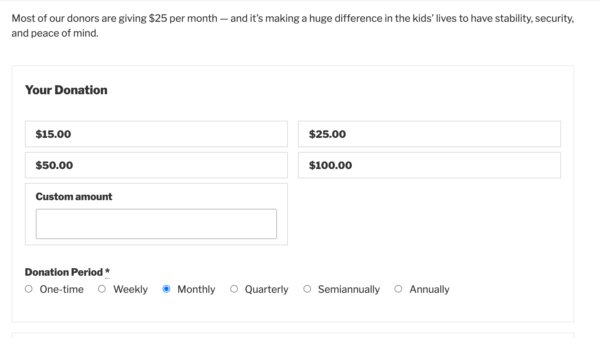
Imagine the great work your organization could do if you knew you would have several thousand more dollars each month for the foreseeable future. That kind of regular income can shift many nonprofits away from constantly worrying about money to expanding their programs and properly paying their staff.
That’s why monthly giving can be a lifesaver for your nonprofit. Unlike one-time gifts, recurring donations create a steady stream of income. What’s more, that income will keep growing over time, giving you a reliable source of revenue that you can depend on.
Monthly giving programs are a crucial part of the fundraising strategy for nonprofits and allow you to generate more donations on a recurring basis. These monthly gifts provide an important source of steady revenue so you can plan your budget, make strategic decisions, or offer predictable funding in response to emergencies.
In this post, we’ll discuss the importance of monthly giving and give you a step-by-step strategy for maximizing your monthly giving program.
What is a monthly giving program?
Monthly giving refers to donations that automatically repeat every month. Each month, when you add more recurring donors, your income will grow.
You may already have an option on your donation form for monthly giving — it’s a standard feature in many donor management packages. However, without a coordinated program to encourage donors to give regularly, the feature is not very useful.
A solid monthly giving program will encompass everything from your social media posts to your email campaigns. All your communication points with donors can be ushering them toward the idea of small monthly donations.
Why stress monthly giving?

When a donor is on your website, credit card in hand, ready to donate, the most challenging part of your work is done. You’ve brought them to your site, won them over, and convinced them to give. At this moment, it’s a tiny mental step for them to move from “I’d like to donate to this nonprofit” to “I’d like to be a regular part of this organization’s mission.”
After all, they’ve decided they can spare $25 this month, so why not every month?
But to your organization, the total donation over a year is more than ten times what the donor would have given once. You’ll follow up with your regular gratitude emails, but you won’t have to convince this donor to get their credit card out again. Furthermore, regular donors often become more deeply attached to your organization — which might make them more responsive to special campaigns and giving days.
But the greatest value of recurring donations is peace of mind. Imagine what it would feel like to know that you have a sustainable amount of income scheduled to come in next week, next month, next year. When you build a steady source of revenue, you’ll be able to make plans, hire staff, and create programs with confidence.
Every month, as you bring in new donors, they’ll be adding to a sustainable source of income that grows predictably and steadily over time.
Is there a downside to monthly giving?
Some development directors worry that stressing monthly giving too much will alienate donors who only want to give one-time gifts.
That doesn’t seem to be an issue with online giving — people have grown accustomed to the monthly subscription model in the online world — but you might want to be cautious about overstressing monthly gifts in direct mail and at events. Offline donors still tend to give the largest gifts, and they are less likely to use a card or be interested in recurring donations.
However, there is one potential downside to a monthly giving program that is real. You’ll have more small donations coming in, almost entirely by credit or debit card. That means you’ll pay more in processing fees (although many donation pages give donors the option of offsetting the fees) and more bookkeeping for your staff. Recording all those small transactions can add up to quite a lot of staff time if you don’t find a way to automate your recordkeeping.
Why many nonprofits struggle to build a monthly giving program
Many organizations don’t put enough effort into making donors understand the value of a monthly gift.
You can’t build a recurring donation program just by offering a “make it monthly” checkbox on your donation form. In fact, you can’t even use that checkbox to gauge interest in monthly giving.
If you want a robust private donation program, you’ll need to commit to asking for monthly gifts first. You’ll still want to make one-time giving an option and make those donors feel appreciated. But it’s vital to put monthly giving first, at least in your online donation drives.
Communicate to your donors how valuable these recurring gifts are, and don’t be afraid to ask for them.
How to create a monthly giving program to generate more recurring donations

Creating a sustainable monthly giving program involves almost every aspect of your development work, from your donation pages and thank-you emails to your newsletter and social media posts.
Here’s how to create a successful monthly giving program, step by step.
Step 1: Design your monthly giving program
Before you start soliciting recurring donations, refine your vision of what the program might look like.
For example, what will your recurring donors receive in exchange for their commitment to donate every month, year after year? Will you give them a special designation in your annual report? Will they have their names featured on a monthly donor wall? Will you send them special thank-you cards or gifts?
Some organizations create a tiered program, with each monthly gift amount tied to an impact statement, such as, “Your $25 per month allows a child to attend school.” But it’s not necessary to create a tiered structure or to offer specific gifts or recognition.
Some nonprofits simply let the donors choose a monthly amount that suits them.
Set an initial target for your monthly giving program, if only to give you something to talk about in your emails and social media campaigns. Set the goal within easy reach so your staff and donors can enjoy a celebration of its success. You can have a new goal each year.
Pro tip: You can get early buy-in with a donor survey. Ask questions like “Which name do you like best for a monthly giving program?” and “What amount seems like a manageable monthly donation to you?” The input will be valuable, and donors who feel like they helped create a program are much more likely to support it when it is launched.
Step 2: Refocus your donation pages

The next step is to create donation pages that stress monthly giving. You’ll want to weave references to recurring gifts into your copy. Mention it in your headline or subheads, and make sure your call to action stresses the monthly donation.
Use the words “your monthly gift” throughout the page, and focus on the impact of a recurring gift. Tell donors about the stability their monthly contribution would lend to your programs, your staff’s peace of mind, and the population you serve.
Although it should still be possible for donors to give a one-time gift, your page should prioritize monthly giving every step of the way.
The technical end of focusing your page on monthly gifts is often more challenging than the copy.
- Some donation software will only create pages with a checkbox for giving monthly. If that’s the best your software can do, see if you can set the monthly box checked by default (while making sure donors understand that if they don’t uncheck the box, their gift will be monthly).
- If you’re using a shopping cart that isn’t donation-specific, like WooCommerce or PayPal buttons, look for the word “subscription” to create recurring gifts.
- If you’re using dedicated donation systems and don’t see a setting for recurring gifts, you may need to upgrade or buy a plug-in. Many programs, like the Charitable WordPress plug-in, don’t include recurring donations at the lowest price point but do offer it as an add-on.
- Make the call to action prominent and make the text on your submission button clear. Use language like “YES, I want to start supporting [organization] with a regular monthly donation.”
- Include clear and complete instructions for creating both an ongoing and one-time donation above your donation form or just above the submit button. You don’t want people to be confused about how to give the way they prefer.
- If your donation system automatically generates emails and receipts, take a moment to update those. Some systems, like Little Green Light, will automatically generate specific emails for one-time or recurring donations. Think of the thank-you email and receipt as two extra chances to make sure your donor knows their gift will automatically recur monthly.
Step 3: Shift your social media posts toward recurring donations
Now that you have a donation page that prioritizes monthly giving, start sharing it on social media. Here are some ideas for social posts to promote your campaign:
- Set a reasonable goal for your monthly giving program, and share regular updates about your progress toward the goal. (“We’re halfway there!”)
- Send shout-outs to welcome your new monthly donors.
- Share impact posts: What changes can you create for $25 or $50 a month?
- Tell your followers how excited you are about the monthly giving program and why. What will it do for your organization, your mission, your clients?
- Share the link to your recurring donation page with a simple call to action.
- Sprinkle these posts across the next few weeks, and mix them in with some of your followers’ favorite content.
Step 4: Reach out to existing donors
The best target audience for your monthly giving campaign is your existing pool of donors and the audience members who open most of the emails you send. These people are your biggest fans. Create a campaign that will persuade them to set up a recurring gift.
Describe your monthly giving campaign. Stress the ease of “set it and forget it” donations from their perspective and the impact of sustainable income for your organization. Ask them if they would consider becoming more involved with your mission by becoming a monthly donor.
Send another email to the same list each time you celebrate a milestone, like halfway to the goal, or only $$$ left to go. Extend your gratitude toward those who’ve joined your family of recurring donors, and invite the rest to join in as well.
Step 5: Rebuild your automations
Turn your attention to your automated email series at this point. You’ll want to tweak your welcome series for new list members or one-time donors to highlight recurring donations.
An automated welcome series usually consists of two or more emails sent to new list members. The first message welcomes them, and the second one usually invites them to connect with your organization on social media.
Add another email to your series describing the impact and ease of monthly giving. Send it to list members who have not already set up a recurring gift.
When someone gives a one-time donation, they should automatically receive a receipt and a thank-you message from within your donation system. Add an automated email to invite them to become monthly donors. Send this message a few months after their initial donation — after they’ve received a few newsletters and other communications that didn’t ask for money.
Step 6: Test and adjust
Approach your monthly giving program with a sense of curiosity, and treat every post, email, and campaign page as an experiment.
You may want to create more than one landing page using different language, colors, or photos and see what performs best. In some cases, just changing the color of the donation button can significantly impact performance.
Test your emails by sending one message to half your audience and a different message to the other half. See what messaging works best.
Keep tabs on what’s working best and what isn’t landing, and use that information to refine your approach as you go.
How to communicate
Promoting a monthly giving program to your donors is a sensitive thing. You want them to see the value of recurring income to your organization, but without giving the impression that you don’t appreciate one-time gifts as well.
Here are some ideas for the wording you can use in your social media posts, emails, and landing pages.
- Focus on gratitude. Imagine, from a donor’s point of view, the difference between hearing “We want you to give a monthly gift so we can feel financially secure” and “We are so grateful to those who are offering us the stability of regular monthly income. Those recurring donations — no matter how small — are helping us feel more secure about our future.”
- Appeal to what they know. Ask them to imagine how difficult it would be to create a budget for their family if they had no idea how much income they might have this month or next month. You can gently guide them to clearly see the value of a stable income.
- Make them feel like part of a winning team. Instead of sending emails or social media posts about how far you have to go, talk about how far you’ve come. Celebrate each milestone, so you look like a winning organization that they want to associate themselves with.
- Use social proof. Some people are early adopters, but most people want to follow the trend. Every time you publicly thank the donors who have joined your monthly donor program, you send a signal that other people find your program worth joining. That kind of marketing is subtle but very powerful.
- Keep talking about impact. Use examples that are meaningful to your mission and your donors to show the effect of your recurring giving program. “Because of the extra $2,000 per month we now have coming in, we can [something your donors care about a lot]. As soon as we reach the $3,000 mark, we’ll be able to [even more exciting thing]. Will you help us get that work done?”
- Use “you” language. People love to hear about themselves. When you talk about your organization’s accomplishments, include phrases like “Thanks to your generosity” and “Because you’re such an amazing group of donors.”
Summing it all up
Now that you’ve learned about the advantages of monthly giving, it’s time to put this knowledge into action. Design your program, create your recurring donation pages, and start talking to your donors about why monthly giving is so important.
Constant Contact’s email and online marketing tools can help you every step of the way, from setting up automations and email campaigns to creating social media posts. Our digital marketing guide for nonprofits, The Download, has loads of practical tips to help you succeed in your online fundraising efforts.




